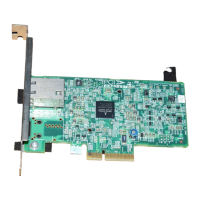Receive Data and Receive BD Initiator Control RegistersBCM5718 Programmer’s Guide
Broadcom®
January 29, 2016 • 5718-PG108-R Page 364
VRQ Status Register (offset: 0x240C)
VRQ Flush Control Register (Offset: 0x2410)
Name Bits Access
Default
Value
Description
Legacy 31:17 RU 0x0 Unused
VRQ Active Bit-Map 16:0 RW 0x0 A position of the Bit-Map shows a 1, in case the
VRQ is currently enabled or recently disabled
and is at the verge of being flushed, and thus
there could possibly be associated traffic inside
the chip.
A bit-position shows 0, when a VRQ is
completely disabled and there is no traffic
whatsoever associated with it either inside the
chip or in the PCIe link between the chip and the
Root-Complex.
Name Bits Access
Default
Value
Description
S/W flush IOV vector 31:15 RW 0x0 S/W Flush vector [16:0].
Reserved 14:9 RW 0x0 Reserved
S/W flush reset request 8 RW/SC 0x0 Software writing 1 to this bit to force an internal
index reset request. Bit-8 combining with [31:15]
bit-map indicates which IOV index group to be
reset. The function is identical to bit-1 hardware
flush reset. This bit is self-clear.
Reserved 7:4 RW 0x0 Reserved
VRQ hardware flush drop
enable
3 RW 0x0 1: Enable hardware drop packet function
immediately when the IOV enable bits are
disabled from driver. This bit will force RDI and
WDMA engines to place the incoming packets
into drop queue when the IOV enable bit is
disabled in EMAC for that particular IOV child
process.
VRQ status update and
interrupt enable
2 RW 0x0 1: Enable hardware triggered host status
interrupt and status block update request.
RDI engine will generate a single pulse request
signal to HC alone with current IOV status vector
value for status block update.
VRQ hardware flush reset
enable
1 RW 0x0 1: Enable hardware local index reset feature
when VRQ flush timer expires.
RDI engine will generate a single pulse clear
request along with current IOV status [16:0]
vector to various modules to clear local
maintained index values for that particular IOV
process.

